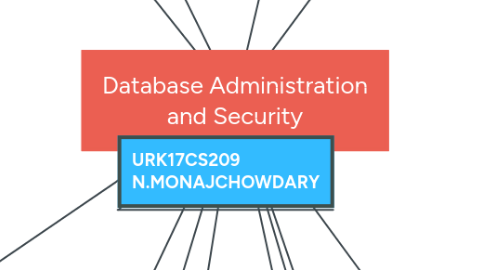
1. DBA's Technical Role
1.1. Evaluate, select, and install DBMS and related utilities
1.2. Design and implement databases and applications
1.3. Test and evaluate databases and applications
1.4. Operate the DBMS, utilities, and applications
1.5. Train and support users
1.6. Maintain the DMBS, utilities, and applications
2. DBA's Managerial Role
2.1. Provide end-user support
2.2. Enforce policies, procedures, and standards for correct data creation, usage, and distribution within the databse
2.3. Manage data security, privacy, and integrity
2.4. Manage data backup and recovery
2.5. Disaster management: Planning, organizing, and testing of database contingency plans and recovery procedures
2.6. Full backup or database dump: Produces a complete copy of the entire database
2.7. Incremental backup: Produces a backup of all data since the last backup date
2.8. Concurrent backup: Takes place while the user is working on the database
2.9. Manage data distribution and use
3. Security Goals
3.1. Confidentiality: Protecting data against unauthorized access
3.2. Compliance: Activities that meet data privacy and security reporting guidelines
3.3. Integrity: Keeping data consistent and free of errors or anomalies
3.4. Availability: Accessibility of data whenever required by authorized users and for authorized purposes
4. Security Policy
4.1. Collection of standards, policies, and procedures created to guarantee security
4.1.1. Ensures auditing and compliance
4.2. Security audit process
4.2.1. Identifies security vulnerabilities
4.2.2. Identifies measures to protect the system
5. Data Dictionary
5.1. Types
5.1.1. Integrated- Included with the DBMS
5.1.2. Standalone- Third-party systems
5.2. Active data dictionary: Automatically updated by the DBMS with every database access
5.3. Passive data dictionary: Requires running a batch process
5.4. Main function- Store description of all objects that interact with the database
6. Using Oracle for Database Administration
6.1. Ensure that the RDBMS starts automatically
6.2. Create tablespaces and datafiles
6.2.1. Tablespace: Logical storage space
6.2.2. Datafile: Physically stores the database's data
6.3. Manage users and establish security
6.3.1. User: Allows a given person to log on to the databse
6.3.2. Role: Authorize a user to connect to the database and use its system resources
6.3.3. Profile: Control how much database resource a user can use
7. URK17CS209 N.MONAJCHOWDARY
8. Data
8.1. Dirty data
8.1.1. Data that suffer from innacuracies and inconsistencies
8.2. Data quality
8.2.1. Ensuring accuracy, validity, and timeliness of dat
8.3. Data profiling software
8.3.1. Determine data patterns and compare them against standards defined by the organization
8.4. Master data management (MDM) software
8.4.1. Helps prevent dirty data by coordinating across multiple systems
9. Need for and Role of Databases in an Organization
9.1. At the top management level
9.1.1. Enable strategic decision making and planning
9.1.2. Identify growth opportunities
9.1.3. Define and enforce organizational policies
9.1.4. Reduce costs and boost productivity
9.1.5. Provide feedback
9.2. At the middle management level
9.2.1. Deliver the data required for tactical planning
9.2.2. Monitor the use of resources
9.2.3. Evaluate performance
9.2.4. Enforce security and privacy of data in the database
9.3. At the operational management level
9.3.1. Represent and support company operations
9.3.2. Produce query results within specified performance levels
9.3.3. Enhance the company's short-term operations
10. Introduction of a Database: Special Considerations
10.1. Technological aspect
10.1.1. Selecting, installing, configuring, and monitoring the DBMS to ensure that it operates efficiently
10.2. Managerial aspect
10.2.1. Careful planning to create an appropriate organizational structure
10.3. Cultural aspect
10.3.1. Listening to people's concerns about the system and explaining its uses and benefits
11. Evolution of the Database Administration Funtion
11.1. Information systems (IS) department
11.1.1. Provides end users with data management support and solutions for information needs
11.2. Database administrator
11.2.1. Responsible for control of the centralized and shared databse
11.3. Systems administrator
11.3.1. General coordinator of all DBAs
11.4. Data administrator (DA) or information resource manager (IRM)
11.4.1. Has a higher degree of responsibility and authority than the DBA
12. Components of a CASE Tool
12.1. Graphics
12.2. Screen painters and report generators
12.3. Integrated repository
12.4. Analysis segment
12.5. Program documentation generator
13. Types of Tablespace
13.1. SYSTEM
13.1.1. Stores the data dictionary data
13.2. USERS
13.2.1. Stores the table data created by the end users
13.3. TEMP
13.3.1. Stores the temporary tables and indexes created during the execution of SQL statements
13.4. UNDOTBS1
13.4.1. Stores database transaction recovery information

